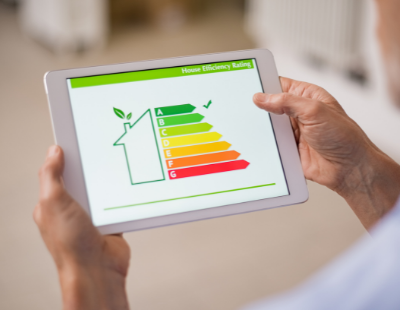
Proposals to force landlords to pay up to £10,000 to improve energy efficiency of rental properties require a rethink, according to the national body for landlords.
In a consultation which closed in January the government proposed that by 2025 all new tenancies in the private rented sector should be in houses with an Energy Performance Certificate rating of C or better. It is proposed that this standard should apply to all private rented properties by 2028.
As part of this the government has suggested that, in meeting these targets, landlords should be expected to pay up to £10,000 to make the necessary improvements.
Whilst the sector is still waiting for the government’s response to this consultation, the NRLA is warning that the planned cap is based on a misguided assumption that all landlords are property tycoons with deep pockets.
NRLA research shows that private landlords make an average net income from property of less than £4,500 a year.
Recent figures have shown the scale of the problem the sector faces in meeting the government’s ambitions.
Across England over 58 per cent of private rented households have an energy rating below a C. Around a third (32 per cent) of private rented homes were built prior to 1919, some of the hardest to improve housing in the country.
The National Residential Landlords Association is calling on the amount that landlords should be expected to contribute to be linked to average market rents in any given area (known as broad rental market areas) as calculated by the Valuation Office Agency.
Under the NRLA’s proposals this would mean the amount a landlord would need to contribute would gradually taper from £5,000 to £10,000, taking into account different rental values - and by implication, property values - across the country.
Alongside this, the NRLA is calling for a package of fiscal measures to support investment. This should include the development of a decarbonisation tax allowance, no longer applying VAT to energy efficiency and low carbon work and not charging council tax where energy improvements are being made to rental properties when they are empty.
Ben Beadle, NRLA chief executive, says: “We all want to see as many energy efficient rental properties in the sector as possible. Besides being good for tenants, improvements made to rental properties ensure they become more attractive to prospective tenants when being marketed by landlords and agents. However, the government’s proposals for the sector are not good enough.
“They rely on a misguided assumption that landlords have unlimited sums of money and fail to accept the realities of different property and rental values across the country.
“Ministers need a smarter approach with a proper financial package if they are to ensure their ambitious objectives are to be met.”
Want to comment on this story? Our focus is on providing a platform for you to share your insights and views and we welcome contributions.
If any post is considered to victimise, harass, degrade or intimidate an individual or group of individuals, then the post may be deleted and the individual immediately banned from posting in future.
Please help us by reporting comments you consider to be unduly offensive so we can review and take action if necessary. Thank you.

















.jpg)






%20(002).png)



.jpg)
.jpg)







Join the conversation
Jump to latest comment and add your reply
Give us back our money, why not give us back our 10% Wear & Tear allowance, scrap Deposit Schemes, Licensing Schemes, How to Rent and Section 24, then that money can go to give us a super EPC at no additional cost to improve the air quality for people’s health, or are regulators the problem.
Totally agree with NRLA for a package of fiscal measures to include the development of a decarbonisation tax allowance/grants to fund heat decarbonisation and energy efficiency measures , remove VAT on energy efficiency/low carbon work and no council tax where energy improvements are being made to rental properties when they are empty, all wrapped up by a simple & fast process one doesn't need a degree in order to claim.
Further consideration is necessary for a) converted flats whereby external or cavity wall insulation can only proceed if all flats agree, apply & pay for it and b) for block of flats if the landlord / freeholder doesn't agree to issue a S20 for necessary works to proceed, or if they refuse the leaseholder permission to change windows or add internal wall insulation and/or charge a high premium/fee to agree said works.
The NRLA do not represent me.
If I have to spend somewhere between £5-10K on each property the money wil have to come from somewhere. Where?
When all houses have to meet EPC C then I'll be happy to do my part. I'm the meantime, I've sold one so far.
I'm with you on this. The Government have raided our industry too much already. I'm happy to do my part for the environment, indeed I actively support it. The key is that it needs to be affordable and it needs to be ALL homes, not just private rentals. And as for £5-10k per property, then interest free loans and or grants will need to be the order of the day.
Me too. I've sold one. I have tenants on their notice which ends in March and will be selling that one ASAP followed by the other 9..... Enough is enough! I can't wait to get out of the rental game. There's just not enough profit in it any more after taxes, expenses and all the hoops you have to jump through.
My first casualty of EPC C is going on the market in January. Tenants gave notice on a lovely big 3 bed Victorian property - new DG, boiler, rads, fully refurbished over the last few years, but an EPC D. I'm not prepared to waste my money doing 'improvements' to meet the target set by the vagaries of an EPC assessment that are not only inconsistent, unfair & opaque but are also ever changing and incompatible with future heating ideals.
This house could've been a fantastic rental home for a family for many years but now will be sold and probably removed from the PRS. Others will follow soon. EPC C is going to make finding a rental home so much more difficult for many, many families - well done Boris.
I have done exactly the same, though with a more modest 3 bed end terrace, EPC band D and has had new UPVC windows and boiler in last 5 years. I should complete my sale in January. Good news though is the strong market. Sold on first week of being on the market and I had a bidding war with 3 buyers whom wanted this house.
NRLA never mind attacking the cost to improve you should be attacking the EPC system which is not fit for purpose. The cost of running homes (EPC) is being used by the Government to help hit its carbon emission targets - so all my gas heated homes are EPC C whereas my electrically heated home are hitting an E or D. EPCs are a constantly moving target and it is impossible to be sure which improvements will give the C required.
If LLs leave the market as I will, what is going to happen to rents? The tenant pays the price! If LLs are forced to spend lots of money making improvements what's going to happen to rents? Tenants pay the price. Wake up we are a business not a charity. My retirement plans are being decimated by this government and I will be asked to evict tenants who have made their home with me, are happy with their home, the cost of running it just for a worthless piece of paper.
How many properties have an EPC below C because of assumptions used in the EPC assessments? How often are those assumptions wrong? Roof and subfloor insulation are two of the main problems with assumptions. It often exists but there is no documentary evidence to say exactly how much so the EPC assessor has to assume none. Even a Building Control certificate only says it complies with the standards in whatever year and won't be accepted as proof insulation exists even though the BC certificate wouldn't have been issued if it didn't. The general condition of the property or proof of energy consumption should at least allow a 'PROBABLY EXISTS' score.
How many properties have had the improvements listed on the original EPC done and haven't reached the expected score because of changes to the algorithm and the fear assessors have of being audited and being found to have been too generous in their assumptions? If it has been assumed something exists on an EPC it should be illegal to change that assumption on future EPCs without absolute proof that the original assumption was wrong. Properties get bought and sold and paperwork gets lost. There has never been a 'PROOF HAS BEEN PROVIDED' option regarding the existence of insulation. The original EPCs used a balance of probability approach. New EPCs demand absolute proof. Taking core samples to prove the existence of insulation would compromise the integrity of the insulation and vapour barrier so isn't a desirable option.
All forms of electric heating score really poorly. What was the point of Lot 20 if it isn't recognised in the EPC assessment? If good heating controls and programmers boost the score for properties heated with gas central heating why isn't the same true for similar electric heating controls?
EPCs suggest a very limited number of improvements to increase the EPC score. We need a full list of potential improvements and how much they will improve the score by. Some work can be easily done with tenants in situ, such as roof insulation, water cylinder jackets, solar panels or double glazing. Other work such as solid floor insulation or internal wall insulation can only be done to empty properties so would involve evicting the tenant. Some of the suggested work couldn't be done to leasehold, listed or conservation area properties.
If it is assumed the roof is uninsulated why isn't roof insulation suggested as a possible improvement? Solid floor insulation is the first thing listed on several of my EPCs but only raises the score by one or two points and would require me to evict the tenants. Solar panels cost about the same and increase the score by between 7 and 10 points. A jacket for the hot water cylinder also raises the score by between 1 and 7 points (depending which EPC report I look at) and costs less than £20. Same with low energy light bulbs.
So give us a full list of options and allow us to pick the most realistic ones for our properties. Be very cautious about recommendations that require us to evict our tenants.
I think the lack of loft insulation recommendation is due to the software assuming that the loft is inaccessible to insulate, as it was inaccessible to the assessor for measurement/photo. It doesn’t allow for all circumstances though - I insulated the “inaccessible“ bay window of my property by taking off the sarking boards when it was re-slated. After the rest of the loft was insulated, mould began to appear on the bay window ceiling! Insulation can cause its own problems... I think the best option for me is to regain my epc accreditation so that I can establish the best course of action for a property. Sometimes the software can’t give you the best option, eg the easiest way to bump up the rating used to be by installing gas central heating (where there were electric heaters) but the epc wouldn’t recommend this if there was no gas meter, even if there was gas in the building.
Scottish Lad
Roof insulation, not loft insulation. Lofts are easy to assess accurately as long as there is a loft hatch.
Roofs are a whole different matter. Either flat roofs or top floor rooms with sloping ceilings. The insulation is completely sandwiched between plasterboard and roof covering with no access to it whatsoever.
In the case of houses with large areas of flat roof if the choice was solid floor insulation or putting 120mm of Celotex and some EPDM on top of the existing roof to get the required score I think the roof would be the preferred option for most people. EPC assessors don't list both options, they only suggest ripping up the floor.
As you say insulation can cause mould problems especially if breather membranes, vapour barriers and ventilation aren't correctly built in.
Some of mine are D a few are pre-war, difficult & expensive to upgrade impossible if not vacant. One is an E and 6 are ‘C’.
Andy, congratulations you got the price you asked for without hanging around with sleepless nights. I heard a famous man once say in TV interview when asked how he got so wealthy, he said by selling too soon.
A lot of this government nonsense comes from charlie and carrie. Insulation is normally made from oil or gas (can be coal) so you either make carbon upfront or later. Further CO2 is afertliser. Smartt meters are costing a fortune in infrastructure and why does one need a meter to tell oneself that electric heating is expensive.
I wonder if Johnson uses recyclable nappies. ? or does he send his babys crap to landfill.
Where does Beadle get the idea that landlords get £4.5k net income? per property I spoke to some people at a landlords convention that arent covering expenses. If one did maintenance, cleaning, decorating administration, mortage interest, loan repayment bad debts, and project management tidying up, downtimes etc then it would be more than the rent ! (Thats why Thatcher dumped council houses.) A letting agent charges me 12 1/2% plus vat to administer. Most tenants last 2 years so that costs another (5 weeks rent?.) Further tradesmen and materials are plus 20% vat. And of course, cheese and wine meetings !
Just a quick few tips for landlords regarding EPC's
1, my top tip is, if you have a property with a boiler & all the habitable rooms are heated by this method then try to remove any other types of secondary heating. An example would be a house with a modern condensing boiler & electric fire in the living room. Without the fire the EPC rating would be roughly 4 points higher, (gas fires also knock the score down 2-3pts). There will be many properties just below a C & without spending much the score can easily be raised.
2, if you insulate any walls, roofs, etc take photos. Take one of the front of the house/flat before you start. Photos should show the insulation on the walls (so before its plastered up), a photo showing thickness also helps.
3, wall insulation the minimum required to be counted is 25mm Rigid foam boards of insulation (such as Kingspan or Celotex), or 50mm rockwool.
4, let your tenants know the inspection involves going into the loft (if there is one), assessors often go to properties where loft access in a cupboard in the bedroom & if its full & they cannot get their ladders in they won't but the score will be reduced considerably if there is insulation in there.
5, all electric properties score really badly (due to the cost of electric over gas), in all electric properties where the hot water is heated via immersion if you are a few points off hitting a band C consider asking the utility to swap the meter to E7. This assumes the water is heated off peak giving those extra points (4-6).
I hope the above helps GL
Thank you for the information. As a landlord this is what I/we need. Hard facts that tell us how many points we get for each improvement we make. An example is somebody whose property is only several points under a C rating so the property will be rated as a D. So removing the electric fire would make it a C. Once again thank you very much.
I insulated my block of 100 flats with 110 mm of external rockwool. Some of the flats went from C to D because the governent has changed the algorithm. I will overcome this by having heated corridors as this will bring the rating back to C, fully working electric heaters which will never be switched on.
It’s carrie’s advisors , follow the money …. The usual suspects
Totally agree with many of the opinions stated here already but a few stick out, like the £4.5K net income - I assume profit - per property, maybe readily achieved in the Home Counties and in cities around the UK but for many locations it not realistic by time one takes out the associated expenses.
As for the st6atement that " over 58 per cent of private rented households have an energy rating below a C", again the more modern properties possibly with associated profits greater than £4.5K may have EPC ratings of "C" but for the older housing stock that is standard in many "not so well off" areas of the UK that percentage increases dramatically.
Once again the private Landlords are seen as a soft touch, why not - in the name of saving the planet etc - does the Government impose the same criteria on Social Landlords and also properties owned by private individuals and business premises if you are going to do it at all.
As with others, after many years as a Landlord I have started shedding properties purely as a result of the ever increasing, ever ridiculous impositions made on Landlords.
For the life of me I can't understand what all the fuss is about landlords not being able to improve the energy efficiency (and therefore the EPC) of their investment buildings. I, like thousands of other professional landlords, realised this when EPCs were introduced way back in 2008. It not like the Government has sprung it on us!
Over the years I've been spending some of my annual rental income on improving loft insulation and cavity wall insulation. I've used external wall insulation on one of my properties - the EPC up-lift for me and energy cost saving for the tenant have been extremely good.
I've recently installed Dimplex Quantum night storage heaters in a rental flat. I've helped my tenant sign-up to an off-peak electricity tariff, which is a fraction of the cost of expensive 'day time' electricity'. Night storage heaters have come on massively since the 1980s and retain the heat all day whilst the tenant is out at work. It's a pile of bricks in a steel box and is ideal for rental homes where the tenant can be less than careful.
A domestic EPC is an energy COST calculation, the worse the Grade the more my tenant has to pay to the NPower, British Gas (and indirectly the Qatari Royal Family and Vladimir Putin) and the less money they have to pay my rent. It makes good financial sense to drive down the money my tenants have to pay in energy costs. Don't landlords on this Blog understand this? Every single resi landlord mate of mine in the Thames Valley has either fixed-up their houses and flats to EPC Grade C or long since sold their 'difficult' assets and reinvested the capital in energy efficient homes (which can indeed be both older or modern buildings)
For me and other professional landlords this simply is not an issue and not a problem. Relaxing Planning regulations so I and others can build a few more houses and flats for renters would be a far better issue for us all to campaign on. Domestic EPCs and MEES is NOT what rational landlords worry about.
I take your point but the problem is that the rules keep changing, the government is not giving clear guidelines and perhaps not appreciating that sometimes it is not cost effective to upgrade a property and occasionally not physically possible. Stories of 100 year payback times are reported usually with underfloor insulation. Sometimes expensive improvements even degrade the EPC (see my comment above), photographic evidence is rejected on the grounds that he photographs are more than 3 months old even when the insulated flat roof to which they apply is 15 years old.
Please login to comment